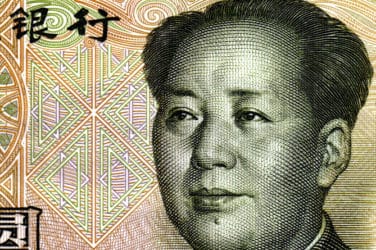
Roger Rutherford, chief operating officer of ParFX, said there has been an encouraging start to offshore renminbi trading on the electronic spot foreign exchange platform as Alan Higgins, UK chief investment officer at Coutts, said markets are overestimating how much a slowing Chinese economy will hurt growth in the rest of the world.
On 14 September the USD/CNH (offshore renminbi) currency pair started trading on ParFX, the institutional electronic trading platform for spot foreign exchange, designed by the Swiss interdealer broker Tradition.
Roger Rutherford, chief operating officer of ParFX, told Markets Media: “CNH is a nascent market and with such a relatively new, but increasingly relevant global currency, it is essential that traders feel confident in their ability to execute, hedge and trade risk efficiently. Our founders designed ParFX to reintroduce fair and transparent trading to the spot FX market and according to customers and prospects, this was a paramount factor for market participants when deciding to introduce and trade CNH.”
Dan Marcus, chief executive of ParFX, said in a statement that the Chinese currency is one of the fastest growing in the world although it is still in the early of stages of internationalisation. Trading volumes have grown since the introduction of spot trading in the offshore market in 2010 and renminbi trading centres have emerged in Hong Kong, London and Singapore.
Rutherford added: “The Chinese authorities have developed the offshore market in a robust manner and customers are comfortable with the operational procedures surrounding the settlement procedures and access to liquidity, all of which underpin growth.”
Chris Knight, head, e-FX trading (East) at Standard Chartered Bank, said in a statement: “Offshore renminbi trading was almost non-existent five years ago but today ranks amongst the top-five most traded currencies globally. Given China’s role as a regional and global business hub at the centre of economics and commerce, it has become critical for us to trade CNH in an orderly and fair environment.”
As a new currency CNH is not yet part of the CLS, the bank-owned physical settlement system for foreign exchange that was set up to eliminate settlement risk in the FX market.
“When a participant trades on ParFX, regardless of currency, they immediately know that their counterparty is a member of the CLS community,” added Rutherford. “This, in combination with the fair and transparent trading environment we provide, offers a level of reassurance and peace of mind that does not exist on other venues.”
Rutherford said the start of CNH trading has been very encouraging with good price discovery and depth of book. “A significant amount of interest came from the Asian market and that will help us build a foundation in that region,” he continued.
Colt, the technology provider which supplies network, voice, data centre and managed cloud services to connect traders to markets, said that despite the market volatility in China this year Asian Pacific markets still offer some of the most lucrative trading venues for both buyside and sellside traders.
Richard Man, head of Colt Capital Markets Asia, told Markets Media: “The increase in volatility has been so sudden and extreme that some buyside firms have responded by sitting on the sidelines and waiting for markets to settle down. However some high-frequency firms that trade Asian markets have welcomed the volatility as volumes have been high.”
Man said the volatility is likely to have a short-term impact and in Japan, the largest high-frequency market in Asia, quantitative easing is set for the next few years.
“We are looking at China and if there is enough demand we will look at providing Shanghai data though HKEx colocation,” he added. “However our priorities are PrizmNet and to broaden opportunities in Asian infrastructure.”
Colt PrizmNet is a financial services extranet which connects providers of financial content, including market data and research, to capital markets firms. Providers who have agreed to distribute content include NLX, Nasdaq, Japan Exchange Group and Aquis Exchange.
“Asian capital markets are nascent but they are in the ascendancy due to the over-regulation in US and Europe,” Man continued. “There is no indicate that the spigot is being turned off, especially in Japan.”
At Coutts, the UK wealth manager, Higgins said in a note today that exports to China are only between 2% and 3% of global gross domestic product and that half of China’s imports are intended to meet domestic demand. “Exports to China are therefore not as sensitive to movements in the local economy as exports in other countries, and the knock-on effect to trading partners is reduced,” he added.
“Emerging economies that are heavily reliant on commodity exports are likely to be hardest hit,” Higgins said. “Meanwhile, on a global scale, the resultant fall in commodity and energy prices is likely to boost consumer spending, particularly in more developed economies.”
This month the Institute of International Finance said in its latest Capital Flows to Emerging Markets Report that net capital flows to emerging markets in 2015 will be negative for the first time since 1988, with outflows projected at $541bn.
Charles Collyns, managing director and chief economist at the IIF, said in the report: “We project that non-resident inflows in 2015 will fall to their lowest levels since the 2008 financial crisis. But unlike the 2008 crisis, the reasons are largely internal rather than external – related to rising concerns about economic prospects and policies in China, coupled with broader uncertainties about emerging market growth prospects.”
The IIF does not expect a quick turnaround as net capital outflows are likely to continue at a more moderate pace next year, dampened by subdued emerging growth prospects and the expected rise in interest rates from the US Federal Reverse.
Hung Tran, executive managing director at the IIF, said in the report: “The debt buildup has been particularly pronounced in the aftermath of the global financial crisis as many emerging market corporates took advantage of very low interest rates to raise debt in both local and foreign currency. As monetary policy continues to diverge and the Fed begins liftoff, countries with large amounts of corporate debt, especially in USD, will face difficulties, with rising prospects for corporate distress, weakening capital investment and growth.”





